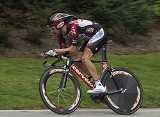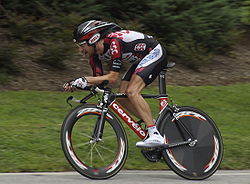
Time trial bicycle
Encyclopedia

Racing bicycle
A racing bicycle, also known as a road bike, is a bicycle designed for competitive road cycling, a sport governed by according to the rules of the Union Cycliste Internationale...
designed for use in an individual
Individual time trial
An individual time trial is a road bicycle race in which cyclists race alone against the clock . There are also track-based time trials where riders compete in velodromes, and team time trials...
or team time trial
Team time trial
A team time trial is a road-based bicycle race in which teams of cyclists race against the clock .Teams start at equal intervals, usually two, three or four minutes apart...
s raced on roads
Road bicycle racing
Road bicycle racing is a bicycle racing sport held on roads, using racing bicycles. The term "road racing" is usually applied to events where competing riders start simultaneously with the winner being the first to the line at the end of the course .Historically, the most...
. Special time trial bikes also exist for use in a velodrome
Velodrome
A velodrome is an arena for track cycling. Modern velodromes feature steeply banked oval tracks, consisting of two 180-degree circular bends connected by two straights...
.
Since the cyclist
Cycling
Cycling, also called bicycling or biking, is the use of bicycles for transport, recreation, or for sport. Persons engaged in cycling are cyclists or bicyclists...
in a time trial
Time trial
In many racing sports an athlete will compete in a time trial against the clock to secure the fastest time. In cycling, for example, a time trial can be a single track cycling event, or an individual or team time trial on the road, and either or both of the latter may form components of...
is not permitted to draft
Drafting (racing)
Drafting or slipstreaming is a technique where two vehicles or other moving objects are caused to align in a close group reducing the overall effect of drag due to exploiting the lead object's slipstream...
(ride in the slipstream
Slipstream
A slipstream is a region behind a moving object in which a wake of fluid is moving at velocities comparable to the moving object . The term slipstream also applies to the similar region adjacent to an object with a fluid moving around it...
) behind other cyclists, reducing aerodynamic drag
Drag (physics)
In fluid dynamics, drag refers to forces which act on a solid object in the direction of the relative fluid flow velocity...
of the bicycle and rider is critical. One difference between a time trial bicycle and a road bicycle
Racing bicycle
A racing bicycle, also known as a road bike, is a bicycle designed for competitive road cycling, a sport governed by according to the rules of the Union Cycliste Internationale...
is the use of triathlon handlebars or aerobars. The main part of the bullhorns curves forward (like a road handlebar
Bicycle handlebar
Bicycle handlebar or often bicycle handlebars refers to the steering mechanism for bicycles; the equivalent of a steering wheel. Besides steering, handlebars also often support a portion of the rider's weight, depending on their riding position, and provide a convenient mounting place for brake...
), but where the road handle bar curves down, the time trial bar ends. This provides a low tucked position that is aerodynamic while providing good stability. The time trial bar also uses a "clip on" bar or aerobar which attaches to the main bar near the stem and provides a position where the hands and fore-arms are close together, low and forward, providing a very aerodynamic (though less stable) position. The aerobar became popular when in 1989 Greg Lemond
Greg LeMond
Gregory James LeMond is a former professional road bicycle racer from the United States and a three-time winner of the Tour de France. He was born in Lakewood, California and raised in Reno, Nevada....
made up 50 seconds to defeat
Laurent Fignon
Laurent Fignon
Laurent Patrick Fignon was a French professional road bicycle racer. He won the Tour de France in 1983 and in 1984. He missed winning it a third time, in 1989, by 8 seconds, the closest margin ever to decide the tour. He also won the Giro d'Italia in 1989, after having been the runner-up in 1984,...
(the race leader) in the final stage (and final time trial) of the Tour de France
Tour de France
The Tour de France is an annual bicycle race held in France and nearby countries. First staged in 1903, the race covers more than and lasts three weeks. As the best known and most prestigious of cycling's three "Grand Tours", the Tour de France attracts riders and teams from around the world. The...
. Time trial races tend to be much shorter than road races, so comfort is less of an issue. Also, control of the bike is less important, since there is little chance of bumping another rider and the courses tend to be less technical with little hill climbing, turns or descents.
Differences from road bicycles
Differences from road bicycles include:- Higher gearingBicycle gearingA bicycle gear or gear ratio refers to the rate at which the rider's legs turn compared to the rate at which the wheels turn. Bicycle gearing refers to how the gear ratio is set or changed. On some bicycles, there is only one gear so the ratio is fixed. Most modern bicycles have multiple gears,...
. Since time trial races are relatively short, the rider can ride at a higher pace. - Deep rim or disk wheelBicycle wheelA bicycle wheel is a wheel, most commonly a wire wheel, designed for bicycle. A pair is often called a wheelset, especially in the context of ready built "off the shelf" performance-oriented wheels....
s, which are more aerodynamic. - The tubing of the frameBicycle frameA bicycle frame is the main component of a bicycle, on to which wheels and other components are fitted. The modern and most common frame design for an upright bicycle is based on the safety bicycle, and consists of two triangles, a main triangle and a paired rear triangle...
may be shaped like an airfoilAirfoilAn airfoil or aerofoil is the shape of a wing or blade or sail as seen in cross-section....
to make it more aerodynamic. - The top tube is usually a couple of centimeters shorter to give an adequate stem length when riding on aerobars.
- Since time trials are usually flat, more emphasis is placed on aerodynamics than weight and handling.
Differences from triathlon bicycles

- a triathlon bicycle will sometimes have a steeper seat tube angle (and thus a more forward saddle position), which places less stress on the hamstring leg muscles, thereby saving strength in the hamstrings for the run which follows the bike portion of the race. Several frames come with a seat post that when installed one way, give the UCIUnion Cycliste InternationaleUnion Cycliste Internationale is the world governing body for sports cycling and oversees international competitive cycling events. The UCI is based in Aigle, Switzerland....
required 5 cm distance from the saddle nose to the center of the bottom bracket and when installed the other way gives a better tri geometry - some triathlon frames do not meet the strict rules governing the design and overall shape of bicycle frames specified by the UCIUnion Cycliste InternationaleUnion Cycliste Internationale is the world governing body for sports cycling and oversees international competitive cycling events. The UCI is based in Aigle, Switzerland....
and adopted by USCF for use in sanctioned event.
The bike leg of a triathlon may be hilly and long (112 miles in the Ironman
Ironman Triathlon
An Ironman Triathlon is one of a series of long-distance triathlon races organized by the World Triathlon Corporation consisting of a swim, a bike and a marathon run, raced in that order and without a break...
), and so the higher gearing, higher weight, and less comfort mentioned above for time trial bikes may not apply to a triathlon bike.

